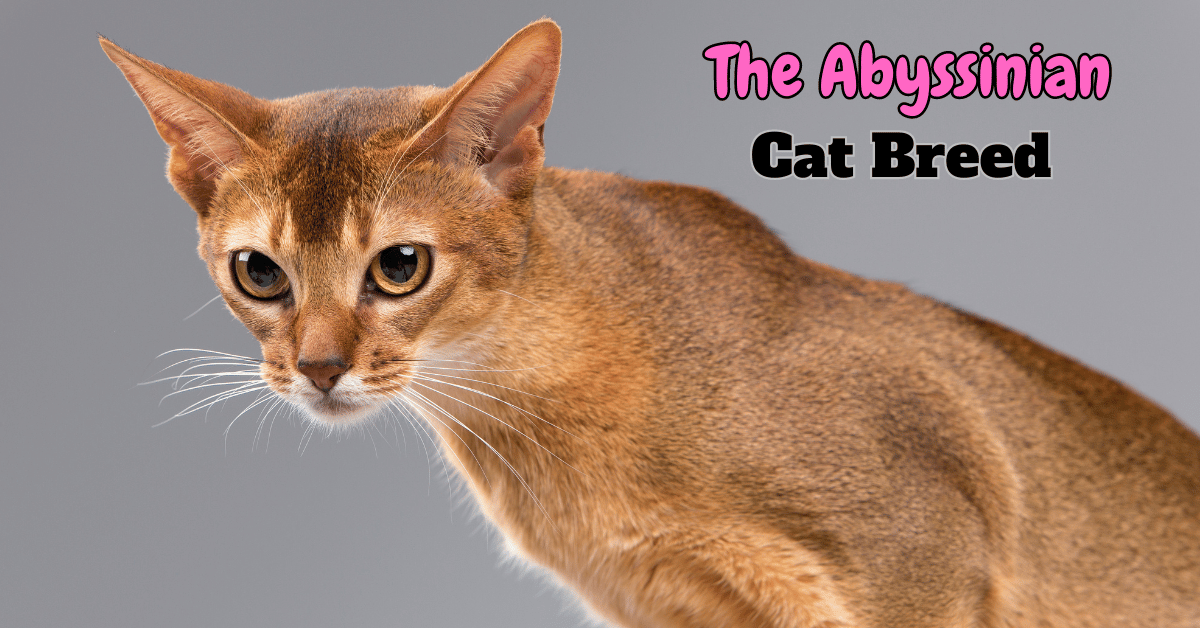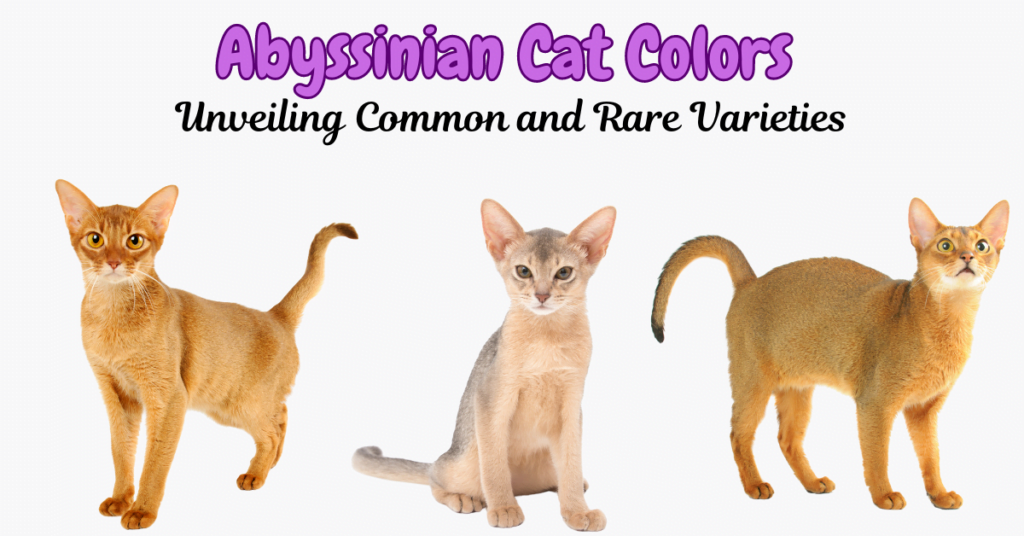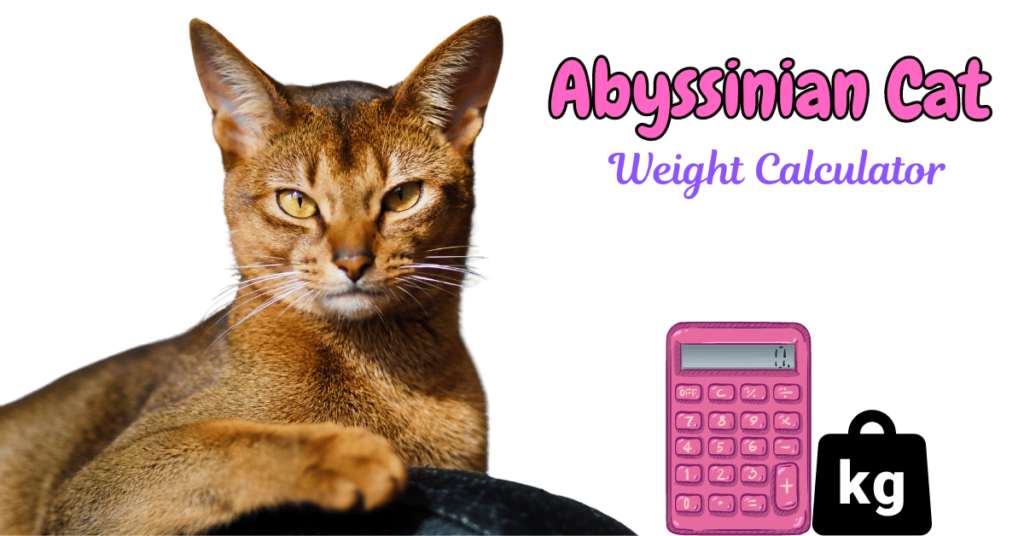Meet the Abyssinian Cat Breed: Elegance & Mischief
Abyssinian cats, described as the ‘clowns of the cat kingdom,’ are among the oldest and most regal breeds known today. These felines blend an elegant and refined appearance with playful antics, earning them nicknames like ‘Aby-grabbys’ and ‘Aby-silly-an’ due to their penchant for grabbing and knocking items off counters.
Whether you’re a seasoned cat owner or considering your first feline friend, the Abyssinian might just leap into your life with its vibrant energy and spirited charm.
Fact: Their quirky and lively nature was famously showcased in the 1978 Disney movie, The Cat from Outer Space.
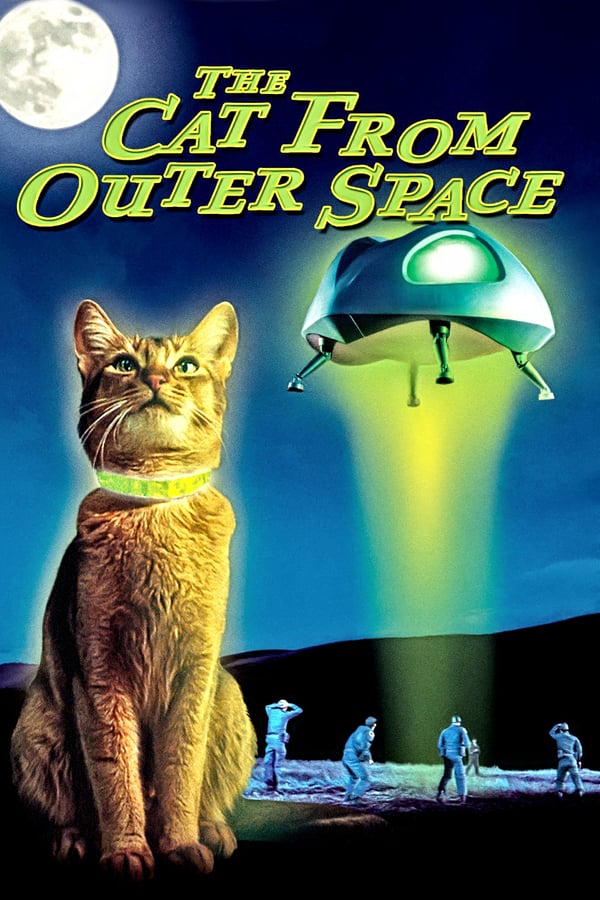
Origins and History of the Abyssinian Cat Breed
The Abyssinian cat breed was first showcased in the UK at the famed Crystal Palace in 1871, highlighting its emerging popularity. The breed’s name, “Abyssinian,” originally suggested an African origin, specifically Abyssinia (modern-day Ethiopia), contributing to its exotic appeal.
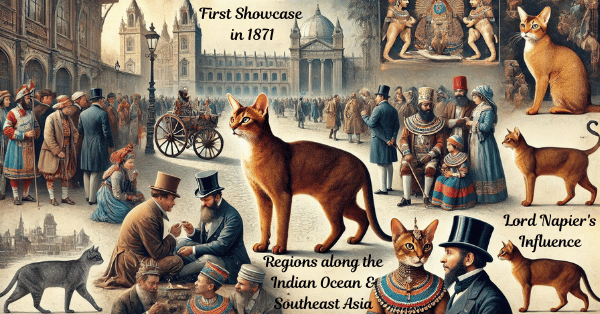
However, the lineage of the Abyssinian reveals a complexity far beyond these initial assumptions. Genetic studies have indicated that the breed likely originated from regions along the Indian Ocean and Southeast Asia, rather than Africa.
This is further supported by the oldest known specimen of what would later be recognized as the Abyssinian breed, preserved at the Leiden Zoological Museum in Holland. This taxidermied cat is labeled “Patrie, domestica India,” hinting at the breed’s Southeast Asian roots.
The breed’s journey to prominence began more conspicuously in the 1860s when Lord Robert Napier returned to Britain from a military expedition in Abyssinia with a cat named Zulu. Zulu’s distinctive ticked coat, which mimicked the wild rabbit’s camouflage, captivated the British public. Her appeal was so compelling that she became the foundation for the Abyssinian breed as we know it today. Zulu was bred with other cats that shared this unique coat pattern, setting the stage for the breed’s development.
Additionally, the first cats of this type imported to the UK were brought from Egypt, which was historically and mistakenly thought to be part of ancient Abyssinia. Their appearance bears a striking resemblance to the cats depicted in ancient Egyptian art, further contributing to the initial confusion about their origins.
Fun Fact: The Abyssinian cat breed faced near extinction twice—first during the two World Wars, when their numbers dwindled severely in Europe, and then again in the late 1960s due to the feline leukemia virus. Each time, dedicated breeders intervened by importing fresh Abyssinians to rejuvenate the gene pool, saving the breed from extinction and ensuring its survival and enduring popularity.
Physical Features of the Abyssinian Cat Breed
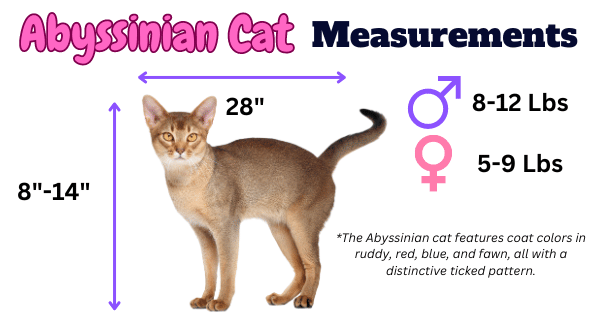
The Abyssinian cat, often heralded as the supermodel of the feline world, epitomizes elegance and athleticism. These cats are renowned for their slender, muscular builds, which highlight their natural agility and refined grace.
They reach full maturity around a year of age and are characterized by several distinctive With a body that can stretch up to 28 inches in length and weigh between 6 to 12 lbs, coupled with a height ranging from 8 to 14 inches, these cats embody a blend of the wild and the refined.
With large, almond-shaped eyes in shades of green or gold, a moderately wedge-shaped head, and some of the largest ears among cat breeds, Abyssinians command attention. Their small oval feet and slender tails, which taper finely and are nearly as long as their bodies, further accentuate their graceful physique.
Their coat is fine, short, and glossy, contributing to a streamlined appearance that seems almost aerodynamic. The most common and beloved coat color is ruddy, a burnt sienna shade that is almost golden, casting them in the majestic aura of miniature lions prowling through an urban jungle. Other color variations include chocolate, red, blue, and fawn.
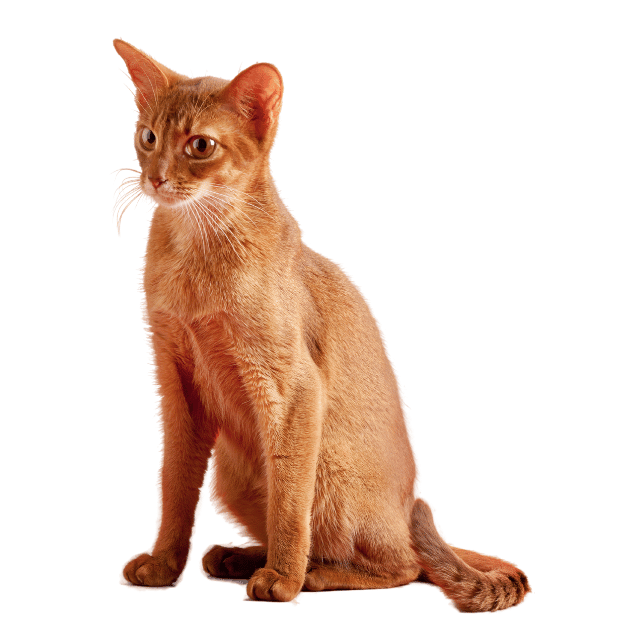
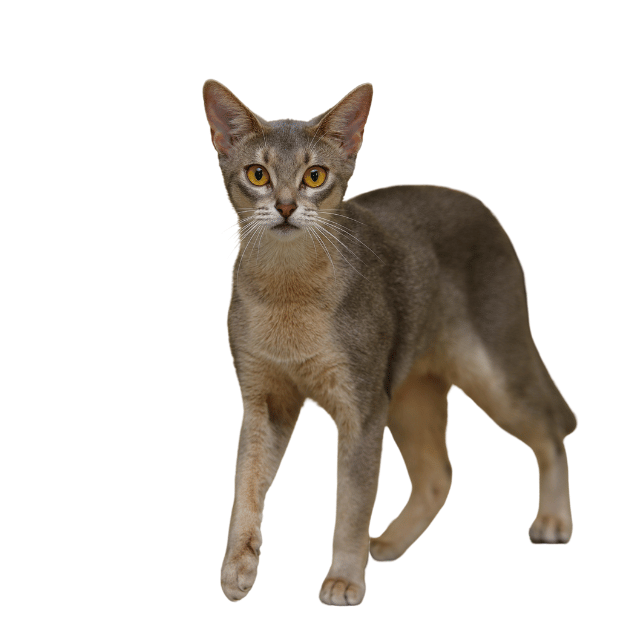
Personality and Temperament of the Abyssinian Cat Breed
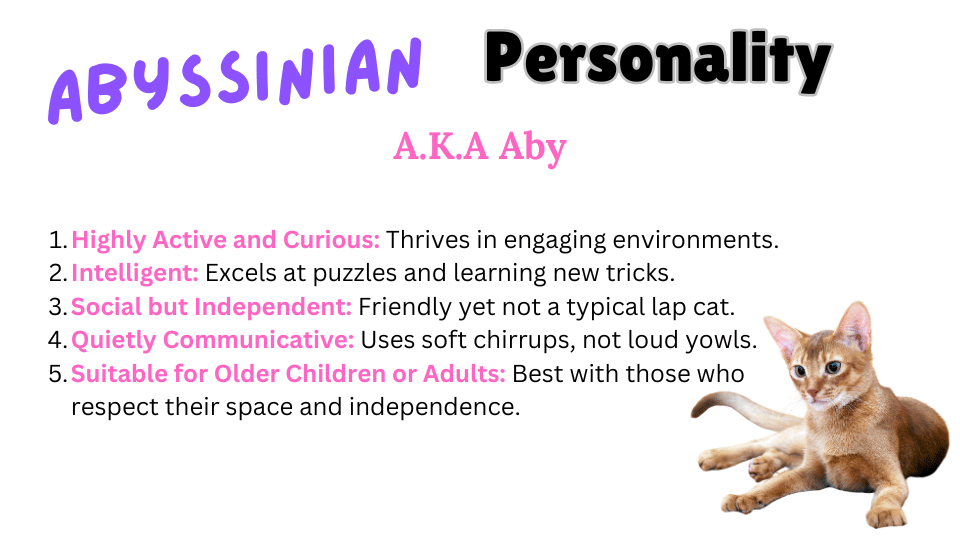
The Abyssinian is celebrated for its highly active and curious nature, making it the perfect companion for those who enjoy an energetic breed and engaging pet. These cats are profoundly intelligent, using their sharp minds to solve puzzles, open doors, and learn tricks that might stump other cats. They thrive on interactive play that challenges their mental and physical abilities, often supervising or involving themselves in whatever task their owner undertakes.
While Abyssinians are social and friendly, they are not typically lap cats. They may not seek out cuddles frequently, but this doesn’t mean they never enjoy affection. These cats are relatively quiet, communicating with soft chirrups rather than loud yowls, and they require a lot of interaction and stimulation.
Without sufficient engagement, they can become bored and potentially destructive. Therefore, Abyssinians are best suited to environments where they can be closely involved with their human companions or have the company of other pets.
Tip: Abyssinians thrive best in homes without very young children, who may not yet understand how to respect a cat’s space and independence. They are perfect for families with older children or adults who enjoy an interactive and energetic pet that behaves much like a ‘cat-shaped dog.’
Health and Lifespan of the Abyssinian Cat Breed
Abyssinian cats, like all breeds, have specific health considerations. Typically, Abyssinians can enjoy a lifespan of 9 to 15 years, but maintaining their health requires awareness of certain conditions that commonly affect this breed.
Common Health Issues in Abyssinians
- Pyruvate Kinase Deficiency: This genetic disorder leads to hemolytic anemia, where red blood cells are prematurely destroyed, impacting the cat’s overall health and vitality. DNA testing is available to identify carriers of this trait.
- Progressive Retinal Atrophy (PRA): An inherited disease that causes gradual deterioration of the retina, potentially leading to blindness. Responsible breeding and DNA testing can help manage the prevalence of this condition.
- Amyloidosis: A serious health condition where amyloid proteins are deposited in organs like the kidneys and liver, which can lead to organ failure. This condition is more prevalent in some lines of Abyssinians.
- Periodontal Disease: Abyssinians are susceptible to gum and dental diseases, which can lead to tooth loss and affect overall health. Regular dental check-ups and proper oral hygiene are essential.
- Patellar Luxation: This genetic condition involves the dislocation of the kneecap, which can affect the cat’s mobility and comfort. It’s important for potential owners to be aware of this risk.
- Hip Dysplasia: Although more commonly associated with dogs, hip dysplasia can also occur in Abyssinian cats, leading to arthritis and mobility issues. This condition results from a malformation of the hip joint.
Care and Maintenance of the Abyssinian Cat Breed
Caring for an Abyssinian cat involves attention to their exercise, diet, and grooming needs. These cats are lively and active, requiring a tailored approach to ensure they thrive in their environment.
Exercise Requirements
Abyssinians are exceptionally energetic and require close to an hour of activity daily to stay healthy and happy. They benefit from having a variety of interactive toys such as puzzle feeders, laser pointers, and automated toys that engage their intellect and physical prowess.
Consider setting up extensive cat trees, jungle gyms, and high perches where they can climb and explore. These setups help mimic their natural inclinations for high vantage points and keep them entertained. For those willing to venture outdoors, training an Abyssinian to walk on a harness can add variety to their exercise routine, allowing them to safely explore new environments.
Tip: While investing in a variety of toys is beneficial for an Abyssinian’s active lifestyle, they often find just as much joy in simple homemade DIY toys, such as a bottle cap or a rolled-up piece of paper.
Diet
Abyssinians need a balanced diet rich in high-quality protein to support their active lifestyle. While their dietary needs are not drastically different from other breeds, their high activity levels mean they may require a slightly higher calorie intake.
It’s essential to monitor their food intake to match their energy expenditure, ensuring they maintain optimal weight and health. Always ensure fresh water is available, and consider using puzzle feeders that make them work for their food, keeping both their body and mind active.
Grooming
Proper grooming is essential for maintaining the health and happiness of an Abyssinian cat. Here’s a guide to the key grooming tasks and their frequencies to help keep your Abyssinian looking sleek and feeling great.
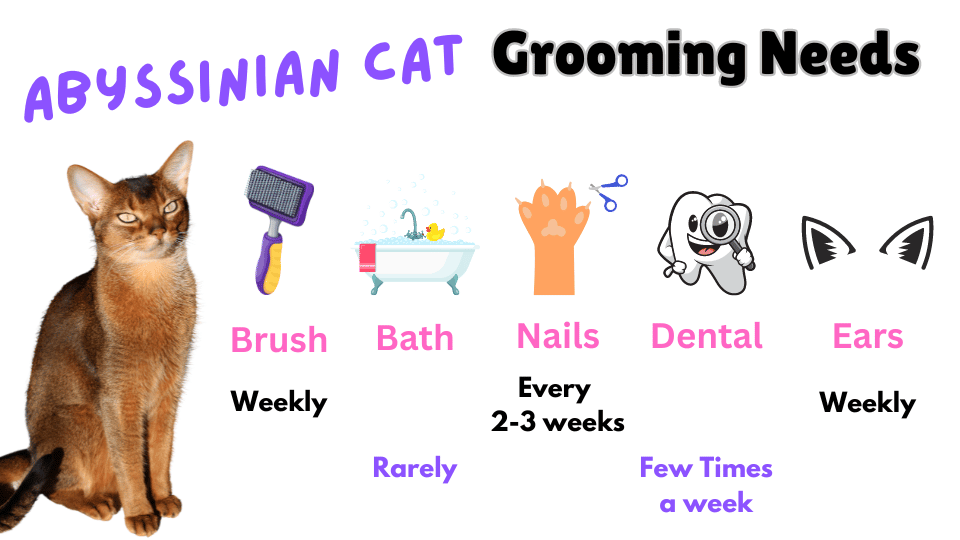
- Brushing: Once a week. Use a soft bristle brush to remove loose hair and maintain the coat’s natural sheen. This regular grooming helps distribute natural oils and keeps their coat healthy.
- Teeth Brushing: One to two times a week. Regular brushing prevents periodontal disease, which Abyssinians are prone to due to their genetic predisposition.
- Nail Trimming: Every 2-3 weeks. Keeping the nails trimmed prevents them from becoming overgrown, which can lead to discomfort and issues with walking.
- Ear Cleaning: Check weekly and clean as needed. This prevents the buildup of wax and debris, which can lead to infections, especially in active breeds that are more exposed to dirt.
- Bathing: Occasionally, only when necessary. Abyssinians generally keep themselves clean, but a bath might be required if they get into something particularly dirty or start to develop an odor.
- Professional Dental Cleaning: At least once a year. A professional cleaning by a vet helps prevent dental diseases and maintains overall oral health.
Tip: Abyssinians adore a good combing or a gentle rubdown with a chamois cloth. Treat them to this pampering session, and you’ll be rewarded with their affectionate purrs.
Final Thoughts on the Energetic Abyssinian Cat Breed
The Abyssinian cat breed is ideal for active individuals or families who can engage daily with these energetic and sociable felines. If you are ready to provide the necessary care, love, and interaction, an Abyssinian will enrich your home with its stunning appearance and dynamic personality, proving to be both a delightful companion and an elegant addition to your life.
Meet Sean, a fintech whiz with a penchant for pet purrs and blockchain buzz. After a decade of fintech feats, Sean’s tech talents leaped from ledger lines to litter lines, driven by a passion for pets and a vision for a more connected pet care community. With three critter companions as co-pilots, Sean launched this blog to share a treasury of pet-friendly tech tips and tales.

